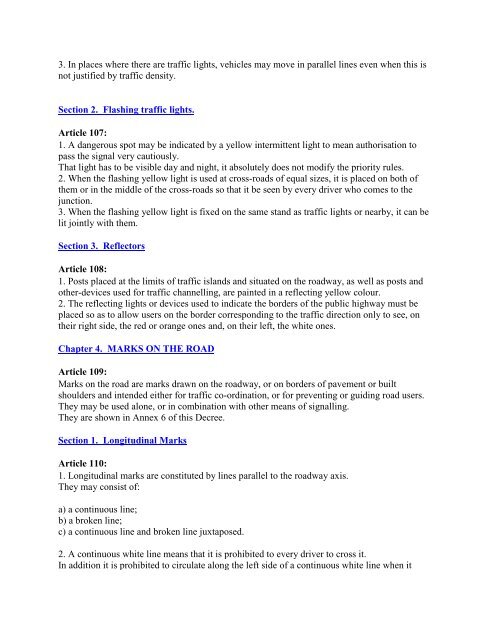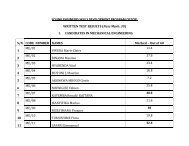lois et reglements police de roulage avec amendements
lois et reglements police de roulage avec amendements
lois et reglements police de roulage avec amendements
You also want an ePaper? Increase the reach of your titles
YUMPU automatically turns print PDFs into web optimized ePapers that Google loves.
3. In places where there are traffic lights, vehicles may move in parallel lines even when this is<br />
not justified by traffic <strong>de</strong>nsity.<br />
Section 2. Flashing traffic lights.<br />
Article 107:<br />
1. A dangerous spot may be indicated by a yellow intermittent light to mean authorisation to<br />
pass the signal very cautiously.<br />
That light has to be visible day and night, it absolutely does not modify the priority rules.<br />
2. When the flashing yellow light is used at cross-roads of equal sizes, it is placed on both of<br />
them or in the middle of the cross-roads so that it be seen by every driver who comes to the<br />
junction.<br />
3. When the flashing yellow light is fixed on the same stand as traffic lights or nearby, it can be<br />
lit jointly with them.<br />
Section 3. Reflectors<br />
Article 108:<br />
1. Posts placed at the limits of traffic islands and situated on the roadway, as well as posts and<br />
other-<strong>de</strong>vices used for traffic channelling, are painted in a reflecting yellow colour.<br />
2. The reflecting lights or <strong>de</strong>vices used to indicate the bor<strong>de</strong>rs of the public highway must be<br />
placed so as to allow users on the bor<strong>de</strong>r corresponding to the traffic direction only to see, on<br />
their right si<strong>de</strong>, the red or orange ones and, on their left, the white ones.<br />
Chapter 4. MARKS ON THE ROAD<br />
Article 109:<br />
Marks on the road are marks drawn on the roadway, or on bor<strong>de</strong>rs of pavement or built<br />
shoul<strong>de</strong>rs and inten<strong>de</strong>d either for traffic co-ordination, or for preventing or guiding road users.<br />
They may be used alone, or in combination with other means of signalling.<br />
They are shown in Annex 6 of this Decree.<br />
Section 1. Longitudinal Marks<br />
Article 110:<br />
1. Longitudinal marks are constituted by lines parallel to the roadway axis.<br />
They may consist of:<br />
a) a continuous line;<br />
b) a broken line;<br />
c) a continuous line and broken line juxtaposed.<br />
2. A continuous white line means that it is prohibited to every driver to cross it.<br />
In addition it is prohibited to circulate along the left si<strong>de</strong> of a continuous white line when it




